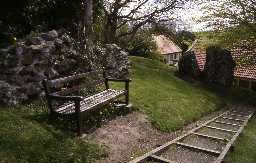Wooler Tower (Wooler)
(NT 99332903) Tower [GT]. (1)
Probable 12th century castle, of which only the mound remains, the bailey having disappeared. It is mentioned in 1360 but was already ruined by the mid-12th century. The present ruin is a late 15th century tower. (2)
It is probable that no stone structure existed at Wooler Castle in the middle ages, for in 1255 it is mentioned as a 'waste mote of no value'.
On top of the mound are a few pieces of broken masonry 6 feet in thickness. These probably represent the remains of a tower first mentioned in 1509, and in 1526 was referred to as the 'new castle'. (3)
NT 99282809. The remains of the tower as stated. None of the masonry is in situ. See photograph (the cross is a modern war memorial). (4)
Condition unchanged. The mound appears to be quite natural, and if it was at one time a 'Mote', it was merely stilised. (5)
There are three big masses of fallen masonry, that nearest the war memorial a section of one corner of the tower, with walls 1.5m thick. One mass of core, with a modern seat set against it, looks as if it might be in situ masonry. The walling is faced with large blocks of pinkish sandstone. No architectural features survive. (6)
Scheduled. (7)
Listed by Cathcart King. (8a)
Although Wooler was a barony,and a motte and bailey had been constructed in the 12th century, the latter was not inhabited as the capital of the messuage. The tower built in 1509 was built on the site of the old motte and garrisoned with 20 horsemen under the control of the warden of the maches. It was badly damaged by 1594 and the £60 required to repair itwasnot raised. (8b)
Probable 12th century castle, of which only the mound remains, the bailey having disappeared. It is mentioned in 1360 but was already ruined by the mid-12th century. The present ruin is a late 15th century tower. (2)
It is probable that no stone structure existed at Wooler Castle in the middle ages, for in 1255 it is mentioned as a 'waste mote of no value'.
On top of the mound are a few pieces of broken masonry 6 feet in thickness. These probably represent the remains of a tower first mentioned in 1509, and in 1526 was referred to as the 'new castle'. (3)
NT 99282809. The remains of the tower as stated. None of the masonry is in situ. See photograph (the cross is a modern war memorial). (4)
Condition unchanged. The mound appears to be quite natural, and if it was at one time a 'Mote', it was merely stilised. (5)
There are three big masses of fallen masonry, that nearest the war memorial a section of one corner of the tower, with walls 1.5m thick. One mass of core, with a modern seat set against it, looks as if it might be in situ masonry. The walling is faced with large blocks of pinkish sandstone. No architectural features survive. (6)
Scheduled. (7)
Listed by Cathcart King. (8a)
Although Wooler was a barony,and a motte and bailey had been constructed in the 12th century, the latter was not inhabited as the capital of the messuage. The tower built in 1509 was built on the site of the old motte and garrisoned with 20 horsemen under the control of the warden of the maches. It was badly damaged by 1594 and the £60 required to repair itwasnot raised. (8b)
N1549
FIELD OBSERVATION, Ordnance Survey Archaeology Division Field Investigation 1955; A S Phillips
FIELD OBSERVATION, Ordnance Survey Archaeology Division Field Investigation 1969; R W Emsley
DESK BASED ASSESSMENT, Land at 27-33 High Street 2005; Alan Williams Archaeology
FIELD OBSERVATION, Ordnance Survey Archaeology Division Field Investigation 1969; R W Emsley
DESK BASED ASSESSMENT, Land at 27-33 High Street 2005; Alan Williams Archaeology
Disclaimer -
Please note that this information has been compiled from a number of different sources. Durham County Council and Northumberland County Council can accept no responsibility for any inaccuracy contained therein. If you wish to use/copy any of the images, please ensure that you read the Copyright information provided.
